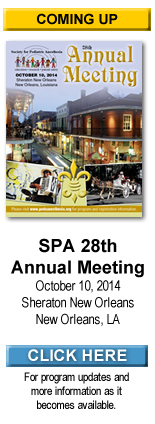Outside the Operating Room: Climbing Denali
Dr. Michael J. Mulick, DO
Children’s Hospital Los Angeles
Los Angeles, CA
Climbing Mt. McKinley, one of the world’s seven tallest summits was one of the hardest things I have ever done. Mt. McKinley, known better by its native name Denali, meaning “The High One”, is the highest peak in North America at 20,322 feet.
My oxygen saturation on the summit was probably in the low 80's. The air temperature was well below zero with wind speeds up to 50 miles per hour. The only things I could focus on were to eat, drink, and keep moving. Climbers at high altitudes experience hypobaric hypoxia. Low barometric pressure causes the partial pressure of alveolar oxygen to be reduced at altitude as demonstrated in the alveolar gas equation:
PA02 = Fi02 * (Pb - PH2O) - (PaCO2/RQ)
On the summit of Denali, the barometric pressure is around 360 mm Hg which translates into a more than 50% reduction in available oxygen. This has profound effects on cognition, cardiopulmonary function, appetite, and sleep.
Denali Expedition (Part 1)
JUNE 8 (Anchorage to Talkeetna)
I flew into Anchorage in early June and the weather was perfect with complete daylight 24 hours a day. My flight arrived at midnight and was one of the most beautiful I have ever taken. I decided to climb Denali with a group of friends made when climbing Aconcagua a few years earlier: Jen, a school teacher from Illinois; Jared, a recent MBA graduate from Boston; Chris, an oil company executive and holder of numerous deep water scuba diving world records; Steven, an executive from Atlanta and his sister Kim, a Colorado climber and ski bum.
Our lead guide, Mike, had six successful Everest summits and had ascended the seven summits five times. Our other elite guide, Larry, had more than ten years of guiding and adventure experience in Alaska. Then there was me, a pediatric cardiac anesthesiologist who grew up in Chicago. I love mountaineering, travelling, and any good adventure.
We took a two-hour bus ride to the small town of Talkeetna, the staging point for Denali expeditions. I immediately fell in love with this small town. You can easily walk everywhere and its dirt roads and local charm make you feel at home. We spent the day practicing tying essential climbing knots, crevasse extraction techniques, ascending fixed lines while wearing an 80 pound backpack, and how to travel as a rope team. We ended the day with a team dinner at the local café, indulging on halibut fish and chips and local lager.
DAY 1: Fly Talkeetna to Base Camp (7200 feet)
The plan was to fly onto the Kahiltna Glacier late that afternoon, but first we had a lot of work to do. We met to discuss our route up the west buttress, the most popular route, first climbed by Dr. Bradford Washburn in 1951. We laid out all our gear and did a final meticulous gear check. Next, we organized our food. Food planning can make or break a climbing trip. At high altitude, hypoxia suppresses the appetite. Climbers at altitude work much harder physically and will inevitably lose weight. Absorption of nutrients is reduced secondary to poor intestinal perfusion.
I climb best when I have a variety of foods with a variety of textures to stimulate more interest in food. My goal was to eat as much as possible, especially high up on the mountain because it’s never enough. In addition to our breakfasts and dinners, I loaded up on cheese, salami, granola, peanut butter cups, chocolate, bagels, and pretzels. Three sacks of personal snack food each weighing in at six pounds gave me a three-week supply.
After registering our climb with the park service and having the rangers scare the pants off us with stories of death and frostbite, we headed over to the Talkeetna airstrip dressed in our “action suit”, i.e. mountaineering boots, glacier glasses, hat and gloves, shell pants, hoodie, and plenty of sun block. It was hot in Talkeetna but we knew that in just less than an hour we would be in an extreme environment. The tension was palpable as we waited for our flight.
We taxied briefly and were suddenly airborne. The flight was INTENSE! Once we rose above the surrounding trees, I saw what an amazing place this was. The mountains off to the north were now in full view. The forested land with swamps gave way to hills and finally glaciers and mountains. Off in the distance it was dark, cloudy, and a bit ominous. The view of all the rock and snow was stunning. After about 30 minutes, we could see base camp on a long, winding river of ice: the Kahiltna glacier.
We circled once and then rapidly landed on the snowfield. Wow, what a start! No hike in. We were already at 7200’ at the base of the big three mountains: Mt. Foraker, Mt. Hunter, and Denali. I was only on the glacier for 10 minutes when I popped through the snow up to my thigh. It had been an extremely warm summer, which meant major instability on the lower glacier and an increased risk of falling through crevasses. Therefore, our plan was to travel the lower glacier at night followed by a day schedule higher on the mountain. Finally, we would switch back to a night schedule for the descent.
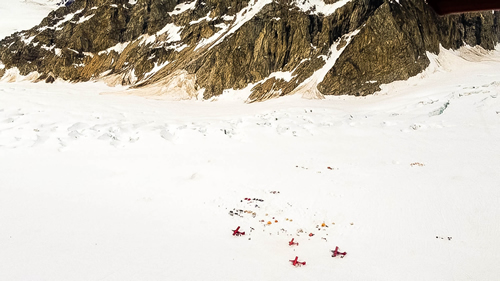
Approaching Denali base camp. The most exciting way to start an expedition.
DAY 2: Move to Camp 1 (7800 feet)
After a short nap, we departed on our first movement on Denali at 2:00 am. Preparing for a move on Denali takes time. All gear has to be packed correctly and everybody needs to time it right so that we tie into the rope at the same time so that nobody is waiting and getting cold. First, I packed my 80 pound backpack. Then I secured the remainder of my share of group gear into my sled. We hauled the sleds behind us so we had to rig them to our backpacks. Then we got snowshoes on, followed by our backpacks.
Finally, we tied the team’s rope to our harnesses and attached the rescue prusik knot to the rope. What a process! Some expeditions use skis instead of snowshoes as they are faster but it is hard to ski with a heavy sled. The sled jerked me around a lot at first. I read a great deal about this during my training and tried to prepare for it, but it’s very difficult to simulate. The hip flexor muscles are not used to this type of work. Then add extreme cold and altitude and voila - the workout of a lifetime! My hips felt it immediately. This was to be the only single carry upward of the trip. For the rest of the moves to high camps, we would shuttle gear in two trips. This served two purposes: 1) Helped us acclimatize and 2) Made work much easier by reducing the load.
We first descended Heartbreak Hill, a nice start as it was downhill. We pushed up to 7,800 feet and it was mostly flat, which was very easy. The largest crevasses of the entire route are all around us. I kept my layers pretty light but by the end of hike I was fairly cold as it was in the early morning hours. The sun doesn’t really go down, but rather goes around the backside of the mountain and it remains very light. Nevertheless, you can certainly feel the large temperature drop when the sun is eerily out of view.
Rather than starting out with thick ski gloves, I wore my favorite lightweight leather gloves and my hands got very cold. Once the sun came into view, it began to heat up considerably. Luckily we made it to camp 1 just after the sun came into view. It took us five hours to reach camp 1 and we were exhausted. Upon arrival, we had to probe the snow for weak spots and locate an area that was safe for setting up tents. Stepping off route or onto snow that had not been probed could be fatal. We set up our tents, which took longer than usual, as we had to deal with the wind. If we lost a tent in the wind, the trip would be over. We had an unusual and amazing dinner of salmon burgers. As previously mentioned, this is the key to staying healthy and enjoying a big mountain trip - eating very well.

The view from my tent at camp 1. How could I sleep with this amazing view?
We tried to sleep but I had a very hard time, as it was boiling hot and extremely uncomfortable inside our tent. Placing the sleeping bags on top of the tent blocks solar radiation and is a great way to cool a tent in hot weather. I also enjoyed lying directly on the ice-cold tent floor. After many hours the wind picked up, it got cooler, and I finally drifted off to sleep.
DAY 3: Carry to 10,500 feet
My wakeup routine was unusual. To start, I completed all chores which could be done recumbent, fully inside my sleeping bag position. This becomes more and more important the higher one gets as the increasing cold requires more energy to stay warm. Today we carried supplies up to 10,500 feet and deposited them as a large cache to be retrieved in a few days. Climbing Denali requires a great deal of digging, depositing, and subsequently digging up these caches.
We ascended Ski Hill followed by a series of gentle hills. Traveling on a rope team is a little strange. You never get to hike next to somebody so you feel a bit lonely although the solitude is peaceful. Even on the rest breaks, spacing is maintained in case somebody falls through a crevasse. Eventually we eased into a comfortable rhythm. I felt so good at the cache that I was eager to dig the pit. We had to dig deep so ravens could not get to the food. Some teams return to their poorly buried cache sites to find them ravaged by these clever birds.
The load-free hike back down felt amazing. The view of the Alaskan range was before us and it was simply magnificent. A lot of people ask why I would bother taking the risk to climb these peaks. It’s moments like this when seeing hundreds of miles in all directions are so glorious that you cannot explain it in words and people would simply not understand unless they had been there. And the feeling of renewed strength while descending altitude while carrying no weight in your pack is exhilarating. It’s a runner’s high times ten.
We spent the afternoon trying to get rest but once again the perpetual light made sleeping hard. I brought a headlamp with me on this trip and I can honestly say that I never turned it on. Not once.
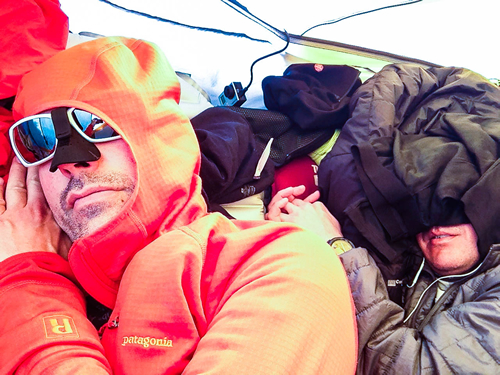
Sleeping during the day requires vigilance for sunburn.
DAY 4: Move to Camp 2 (11,200 feet)
Many other teams were ready before us this morning, which had us a bit nervous as we were a strong team and we feared getting stuck behind slower teams. It’s hard to pass people on this mountain. There is a fairly discrete route that is already dangerous. Trying to go around people by straying off route is suicidal.
Hats off to Larry for making us excellent bacon bagels with hot cream cheese for breakfast. I love learning new things on the mountain but this was the coolest of the trip so far. Take a single serving cream cheese packet and drop it in hot water for a few minutes. When you open up the packet, you have soft cream cheese that spreads easily on a bagel and it’s far more pleasant to eat while hot. Well done, Larry!
We departed as two rope teams at 5:10 with several teams out ahead of us. The wind started up and by the time we took our first rest break, the wind was raging. Our rest breaks were extremely short. On a break I would set down my backpack, relieve myself, retrieve and put on my puffy jacket, sit awkwardly in snowshoes while chugging water and stuffing myself with snacks, then get ready to move again. But it's good that way so one doesn’t get cold.
The wind was harsh and the climb hard. It eased up after we passed our previous cache site at 10,200 feet. We did one more hour of steep hills, then made the big right turn at Kahiltna pass, then left again toward the main mountain. The upper Kahiltna can have pretty terrible weather. I was pretty tired by the end and setting up camp was very hard work that took several hours. This camp is directly below Motorcycle Hill and notorious for crevasse hazards. There have been fatal cases of pulmonary edema here.
After dinner I slept with my sunglasses on, as it was too bright. This environment is extreme. It was rarely comfortable for long. It was either too hot or too cold. We had to constantly be aware of what was happening around us. Changing layers to match the weather is a crucial part of mountaineering.
In comedic fashion I fell down the snow slope to the ice bathroom we had dug. Nobody saw it but I became determined to not do it again so I grabbed the spade and cut some very nice steps in the snow leading down to the bathroom. I enjoyed this little chore and was rather proud of my improvement to the camp.
DAY 5: Back Carry
I slept a ton and felt great! We were spoiled this morning with blueberry chocolate chip pancakes. One of my personal secrets for travel and mountaineering is adding crystal light pink lemonade flavored powder to a liter of water. I learned it in Sudan while working for Doctors Without Borders when I became very sick and dehydrated. The simple addition of the flavor additive really saved me thanks to my friend, Rupa, a pediatrician. It tastes great and keeps me wanting to drink water. The powder itself is just a sweetener. I gave up on electrolyte tablets as even the good ones taste lousy. Provided we eat well, our food contains all the electrolytes we need. We hiked down to 10,500 feet to recover our cache. It only took 15 minutes to descend and then an hour to hike back to camp.
DAY 6: Carry to 13,500 feet
My hands were tingly all night and I was worried about them. I did not suspect frostbite by the way they appeared but it seemed possible since I let them get very cold on that first hike. I needed to be more careful.
From here on up we wore crampons; no more snowshoes. We started the day with a shock to the system by climbing straight up the infamous Motorcycle Hill. It’s the first steep section of the mountain and gets its name from its likeness to steep hills used for uphill motorcycle competitions. We rested at the top and I got my first appreciation for how intense and exposed this climb was going to be. It’s not that it is terribly hard terrain. It’s the fact that one is on hard, icy terrain with moderate exposure, wearing an extremely heavy backpack, hauling a sled, and roped together. A trip and fall by one person can injure the entire team.
We slowly made our way closer and closer to legendary Windy Corner. After reading about it for years, I was seeing this infamous and deadly piece of land for myself. Climbers can be lured there by calm weather only to experience intense wind gusts, sometimes up to 100 MPH. Going around Windy Corner was supposed to be the riskiest stretch of the whole expedition due to rock falls and crevasses hidden by wind blown snow. We moved together silently and successfully passed the dangerous stretch without incident.
We cached our gear quickly and turned around. The goal was to get back around the Corner as fast as possible. Seeing rock debris scattered over our route was not pleasant. Once safely around, we took a rest break, then I lead the team back down to camp. I felt a bit rushed because everyone was waiting for me and neglected to take off my hoodie. I was sweating profusely on the way down. Lesson learned: just take an extra minute to make sure the clothing layers are optimal. In the mountains, you always want to start hiking a bit cold, which is uncomfortable at first, but the body warms up quickly. I had a headache and felt exhausted from the day’s exertions. The heavy loads and tiredness of all the climbers left me feeling nervous.
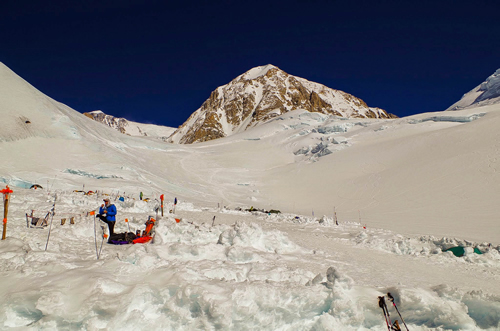
Motorcycle Hill seen from camp 2. Photo courtesy of Kim Hess.
DAY 7: Move to Camp 3 (14,200 feet)
This was a very hard day. After a huge breakfast, we broke down our tents. I hurt my right Achilles by stomping in a frozen tent anchor with my heel. This was not a great start to my day and I thought about how this little mistake could ruin my chance at making the summit. We made a very long hike with little rest until all the way past Windy Corner. Suddenly there were rocks falling between myself and Jared and I jumped to the left to avoid them. Whew! That was a close call.
At our cache site we loaded more gear into our packs. From there to camp it was extremely hot, heavy and slow going. It was probably 95 degrees, an unusually hot day. Upon arrival we first leveled the snow into platforms and then set up the tents. Once the tents were well anchored, we built an ice wall around our tents to protect us from high winds. The team functioned like an assembly line. One or two people would cut ice blocks in the snow. A few people would carry the heavy blocks from the cutting area to the site of our wall. And the rest would create the wall. Then we worked on the kitchen, a huge dugout in the snow, complete with stairs, snow benches, and a counter for cooking. We then erected the canopy for the kitchen. After this I collapsed in my tent and the team took a well deserved nap.
Following dinner we watched some professional extreme skiers and snowboarders from the North Face team ski past us. Among them was top extreme snowboarder Jeremy Jones as well as Jon Krakauer, the author of “Into Thin Air” and writer for Outside magazine. While watching the North Face team make their descent, we saw rocks fall from the ridge at 16,000 feet right down over our route. This was terrifying. Mike said he has never seen this before and he had climbed Denali 14 times. This was a risk not normally encountered on the west buttress route.
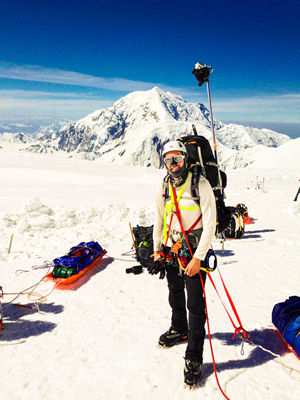
Extremely hot day at Windy Corner.
DAY 8: Rest Day at Camp 3 (14,200 feet)
This was a beautiful rest day! I slept 12 hours and it felt wonderful. So far, expedition activity had fluctuated from extremely hard work to hours of complete laziness where one began to get cabin fever from laying in one’s tent. Some of the team members brought electronic book-readers powered by portable solar chargers. I was content just reading an old fashioned paperback.
There was no rock fall until 2:00 pm and then we observed an alarming amount of rocks falling over the headwall until 4:00 pm and then again at 6:00 pm. Further rock falls in the evening had some of us wondering if we should abort our trip. It was the hottest summer in Alaska in many years.
DAY 9: Acclimatization Hike to 15,500 feet
We got up early and hiked up to the lower part of the headwall to the bottom of the fixed lines. We bundled up and sat in the snow at 15,500 feet for a while and then headed back down. The purpose was to stretch our legs and get a small bit of altitude exposure without exerting ourselves. We needed to get strong for the next few days and we were still very tired from yesterday. Back at camp, we made new snow blocks and bolstered our wall. Again, this was tremendous work. We worked a continuous 3.5 hours on the walls until we realized that one of our teammates somehow slept through the entire process.
DAY 10: Rest Day at Camp 3 (14,200 feet)
There were very strong gusts of wind on and off all night causing the whole tent to shake violently. I was grateful for another rest day. The team slept in and got out of bed around 9:30 am when the sun came around the ridge. After breakfast, we sat in the kitchen tent telling stories and quoting favorite movies. This is when it helps to be good friends with your teammates. You depend on each other for survival and it helps to genuinely enjoy each other’s company. Thereafter, we hiked out to the “edge of the world.” This is the name of the edge of the 14,000 feet plateau upon which we were currently camped. It drops a staggering 4,700 feet straight down to the northeast fork of the Kahiltna glacier. The view was breathtaking.
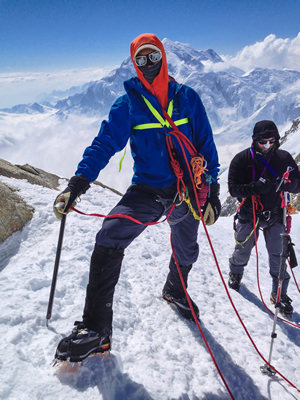
Edge of the world. It's a 4,700 feet straight drop down to the lower glacier.
Many climbers begin to have signs of acute mountain sickness here at camp 3. Denali is unique because of its extreme north latitude (63° North) and cold temperature, which drops the barometric pressure even further. A mountain of equal altitude closer to the equator will have higher barometric pressures than Denali. But it is specifically this lower pressure that makes climbers more hypoxic than expected on Denali. It is more than most climbers have ever experienced. But what does that actually feel like? I thought about my single ventricle patients who live with oxygen saturations of 70’s to 80’s. If they could talk, what would they say?
The next day marked the start of the real part of the climb. Ascending the headwall and ridge with extremely heavy packs, we were going to find out just how difficult and terrifying this mountain can be.
Please look for Part II of my Denali climb in the next SPA News.


